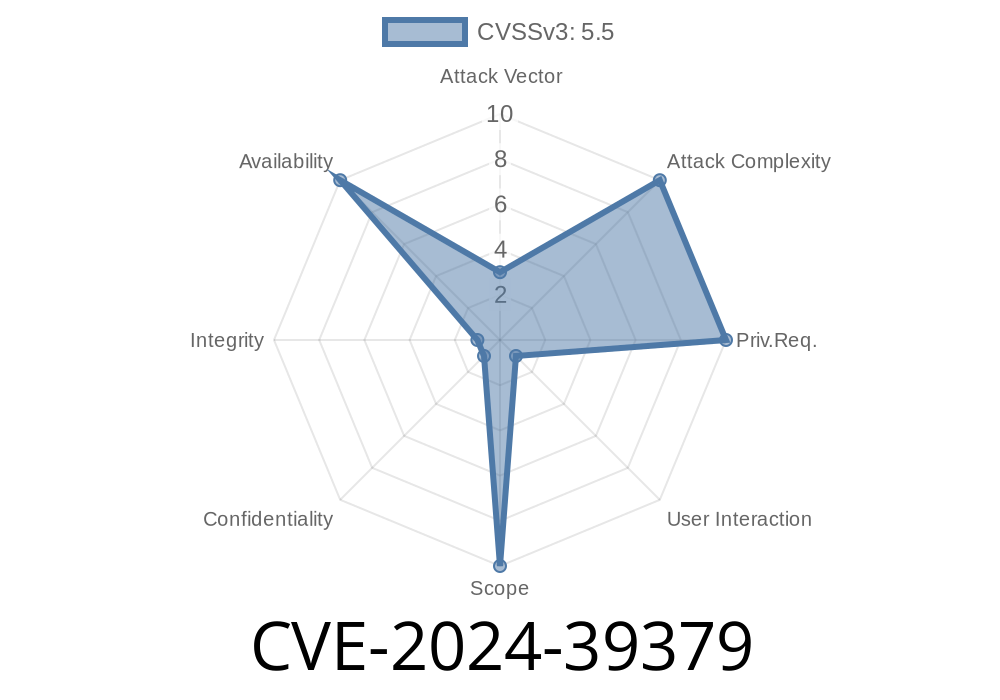Published: June 2024
Author: Exclusive Write-up for SecureInsights
Summary
A major vulnerability, tracked as CVE-2024-39379, was discovered in Acrobat for Edge, affecting all browser extension versions up to 126..2592.81. This flaw is an _out-of-bounds read_ bug that allows attackers to bypass standard security boundaries and read sensitive files from your system—just by luring you into opening a single infected document.
In plain terms: if you use Acrobat in Edge and open the wrong file, a malicious website could silently pull data from your computer that you never intended to share. This write-up will walk you through how CVE-2024-39379 works, the risk level, and what you should do now.
What Is CVE-2024-39379?
CVE-2024-39379 is an _out-of-bounds read_ vulnerability, which means the PDF engine used by Acrobat for Edge can accidentally read parts of your memory it’s not supposed to, spilling potentially sensitive secrets to hackers.
How Does This Happen?
When a user opens a specially crafted (malicious) PDF file using Acrobat for Edge (in Microsoft Edge browser), the extension processes the file and mishandles certain buffers. If a hacker has built the PDF just right, they can trick Acrobat’s code into _reading past the end_ of a memory buffer—gaining access to whatever sensitive info lies in those extra bytes.
Common data at risk: Usernames, partial document contents, browser cookies, or even content from recently opened files.
From Adobe's official advisory
> “Successful exploitation could lead to information disclosure in the context of the targeted user via a specially crafted PDF file.”
> — Adobe Security Bulletin APSB24-61
How Dangerous Is It? (Severity)
CVSS v3 Base Score: 7.5 (High)
Attack Complexity: Low
User Interaction: Required
Privileges Required: None
Email you a PDF
- Encourage you to download/open it via social engineering
Proof of Concept – How Attackers Exploit This
Below is a simplified proof-of-concept Python snippet that shows how a malicious PDF might include an exploit object to trigger the vulnerability.
NOTE: This does NOT include the actual malicious buffer or payload—just a skeleton example for educational purposes.
# Pseudo-PDF generator for CVE-2024-39379 PoC
header = b'%PDF-1.7\n'
obj1 = b'1 obj\n<< /Type /Catalog /Pages 2 R >>\nendobj\n'
obj2 = b'2 obj\n<< /Type /Pages /Kids [3 R] /Count 1 >>\nendobj\n'
# Malicious buffer triggers out-of-bounds read
malicious_obj = (
b'3 obj\n'
b'<< /Type /Page /Parent 2 R /Contents 4 R >>\nendobj\n'
)
# Crafted stream intended to overflow during parsing
obj4 = b'4 obj\n<< /Length 1024 >>\nstream\n' + b'A' * 1024 + b'\nendstream\nendobj\n'
xref = b'xref\n 5\n000000000 65535 f \n000000001 00000 n \n000000006 00000 n \n0000000115 00000 n \n000000022 00000 n \n'
trailer = b'trailer\n<< /Size 5 /Root 1 R >>\nstartxref\n330\n%%EOF'
with open('cve-2024-39379.pdf', 'wb') as f:
f.write(header + obj1 + obj2 + malicious_obj + obj4 + xref + trailer)
How would a real exploit work?
A hacker’s PDF would be custom-built to overflow and spray memory with controlled data, forcing Acrobat to read from memory locations outside the defined buffer.
The attacker receives data from the victim’s memory
- This may include confidential information, tokens, fragments of other open documents, or other user data
References for CVE-2024-39379
- Adobe Security Bulletin APSB24-61
- NIST National Vulnerability Database CVE-2024-39379
- Edge Add-ons Store - Acrobat Extension
Final Thoughts
CVE-2024-39379 is a powerful reminder: even trusted browser extensions can have flaws that let attackers peek into our digital lives. If you use Acrobat in Microsoft Edge, update your extension now, and always be wary of unexpected files—just one bad click can be enough.
Timeline
Published on: 07/31/2024 13:15:10 UTC
Last modified on: 08/01/2024 12:42:36 UTC
